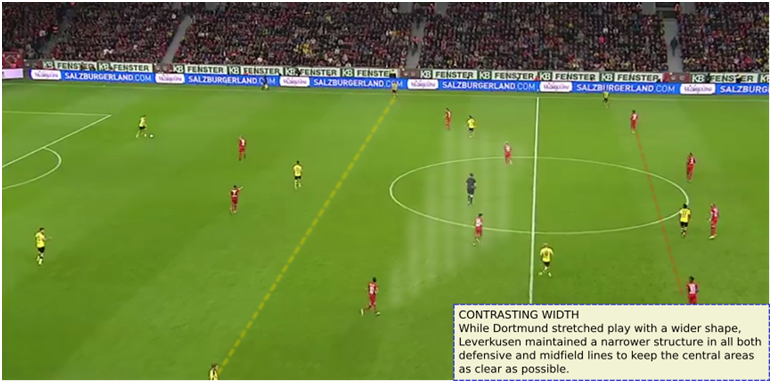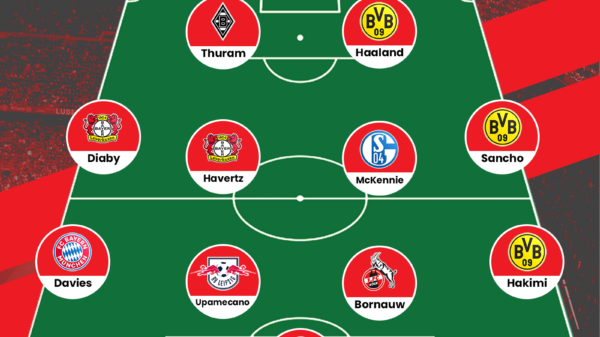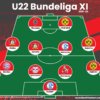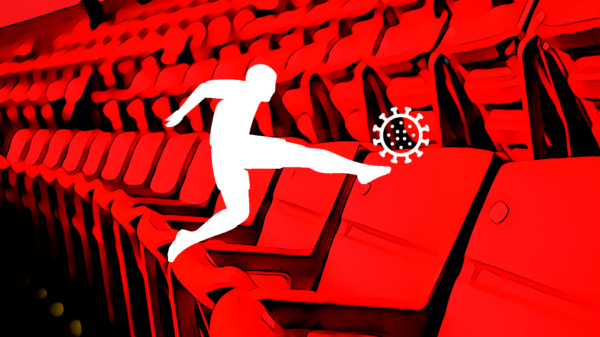Sauharda Karki writes a detailed Tactical Analysis about the Bundesliga match that ended Leverkusen 2-0 Dortmund.
2 great rivals went to head to head this weekend in the Bundesliga as they both tried to take advantage of the slip up by Bayern Munich to edge closer in the title race.
Bayer Leverkusen (4-4-2): Leno; Henrichs, Toprak, Tah, Bender; Calhanoglu, Kampl, Aranguiz, Brandt; Chicharito, Mehmedi.
Borussia Dortmund (3-4-2-1 / 4-1-4-1): Burki; Guerrero, Ginter, Sokratis, Pizcszek; Weigl, Castro, Rode, Dembele, Pulisic; Aubameyang.

Made using TacticalPad
Dortmund Shape and Philosophy contradiction
Dortmund started off with a dynamic shape – a 4-1-4-1 defensively and a 3-defender shape in attacking transition and initial build-up. Raphael Guerrero, Dortmund’s left-back cum central midfielder, was seen constantly switching between left-back and midfield positions during attacking and defensive transition.

This style lasted the first 9 minutes of the game (up until the team conceded a goal). Following the goal, Guerrero was moved to a stable left fullback position, as Dortmund reverted back to the regular 4-1-4-1. This may have been some form of experimentation by Tuchel in the early parts of the game.

The style, however, seemed to contradict Dortmund’s philosophy of closing spaces and quick transitions. The shape left spaces open in wide areas, later exploited by Leverkusen attackers. The constant change in the shape of the defenders also meant a slower defensive transition than usual and more frequent marking mismatches.
Dortmund had already conceded three shots in the first 10 minutes. The second half saw Marcel Schmelzer come on at left-back with Guerrero moving into midfield.
Leverkusen’s compact shape, efficient tackling and midfield press
Most of Bayer Leverkusen’s game plan seemed evident from the way the team was set up. For a side playing at home, the Leverkusen shape was very narrow with the wide midfielders stationed closer to the center forwards and central midfielders. This allowed the team to keep pressure on the defense and central midfield areas, all while keeping central areas unexposed.

A major proportion of the setup aimed at hastening the build up phase to exploit spaces before the opposition completes their defensive transition. This allowed most of Leverkusen’s play to be stationed in the opposition third.
Leverkusen attempted over 35% of their passes in the attacking third (Dortmund – 20%).
The high intensity pressing in central areas of midfield worked wonders for both the defensive purpose, and counter approach in the later stages. This can most likely be attributed to Dortmund’s preference to build up through the middle. The impressive tackling effort, especially in wide areas, added to the pressing approach.
Leverkusen made an impressive 33 successful tackles in the game
They are currently the Bundesliga team with the most successful tackles per game (20.8 per game).
Leverkusen Exploiting wide spaces in attacking transition
The initial stages of the game saw Dortmund’s rather eccentric shape give away large amounts of spaces in wide areas. These areas were soon exploited by Leverkusen’s wide players in attack. The spaces allowed for easier creation of crossing opportunities.

The narrow Leverkusen 4-4-2 in combination with spaces in wide areas allowed for a significantly large number of players to position themselves in the opposition box to get in the end of crosses.

Leverkusen counter approach and Dortmund’s transitional play
Under Tuchel’s reign, Dortmund have slowly evolved into a team that enjoys ball possession. It was no different in this game with them enjoying over 70% of the ball in an away game. The significant ball retention does seem to have had repercussions in the form of a comparatively slower defensive transition.
Adding a high defensive line and advancing fullbacks to the equation makes the tactic very vulnerable to counter-attacking opposition. Dortmund’s unusually slow defensive transition on the day allowed Leverkusen to find a lot more space in their swift offensive transition.
Leverkusen’s narrow shape and style of play seemed to complement their counter attacking approach. With two forwards, attacking transition was a lot quicker for Leverkusen when possession was regained in central areas. In the advanced stages of the game, Dortmund fullbacks began to push forward, leaving even more spaces in wide areas for link-up play on the counter.

Conclusion
The game was a tactical battle from the start, with Leverkusen’s approach proving effective right through the early stages. With a compact structure, tactical discipline and industrious defensive performance, Leverkusen kept most Dortmund attacks at bay. With talented attackers in the side, the side managed to register more attempts (11) than Dortmund (10). The second goal from an incisive counter attack signed off on the efficacy of the Leverkusen game plan, and sealed the game for the home side.
Dortmund’s ‘experimentation’, set up and selection may have played a role tactically in their loss. The attacks seemed a lot more predictable and Leverkusen’s strategy allowed for very little central play in attacking areas which may have added to their offensive off-day. Tuchel’s Dortmund may perhaps be more efficient after deciding on and fielding a regular back-line rather than making constant changes to it.
With the increasing number of tactical systems that emphasize the transition phase, this game, among many, may serve as an example of how transition phases can be both utilized and exploited for the team’s benefit.
Read all our other Tactical Analyses here.
- Premier League: The Growing Trend Of Counter-Attacking Goals - June 11, 2020
- Analysis | Three Things We Learned: NorthEast United 0-1 Bengaluru FC - December 9, 2017
- Three Things We Learned: NorthEast United 0-0 Jamshedpur - November 19, 2017

























































